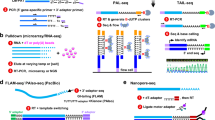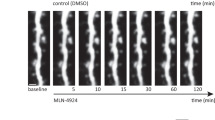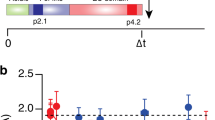Abstract
We demonstrate a rapid and complex effect of N-methyl-d-aspartate receptor (NMDAR) activation on synaptic protein synthesis in the superior colliculi of young rats. Within minutes of receptor activation, translation of alpha Ca2+/calmodulin dependent kinase II (αCamK II) was increased, whereas total protein synthesis was reduced. NMDAR activation also increased phosphorylation of eukaryotic elongation factor 2 (eEF2), a process known to inhibit protein translation by reducing peptide chain elongation. Low doses of cycloheximide, which reduce elongation rate independently of eEF2 phosphorylation, decreased overall protein synthesis but increased αCaMK II synthesis. These observations suggest that regulation of peptide elongation via eEF2 phosphorylation can link NMDAR activation to local increases in the synthesis of specific proteins during activity-dependent synaptic change.
This is a preview of subscription content, access via your institution
Access options
Subscribe to this journal
Receive 12 print issues and online access
$209.00 per year
only $17.42 per issue
Buy this article
- Purchase on Springer Link
- Instant access to full article PDF
Prices may be subject to local taxes which are calculated during checkout



Similar content being viewed by others
References
Martin, K. C. et al. Synapse-specific, long-term facilitation of Aplysia sensory to motor synapses: a function for local protein synthesis in memory storage. Cell 91, 927–938 (1997).
Kang, H. & Schuman, E. M. A requirement for local protein synthesis in neurotrophin-induced hippocampal plasticity. Science 273, 1402–1406 (1996).
Constantine-Paton, M., Cline, H. T. & Debski, E. A. Patterned activity, synaptic convergence and the NMDA receptor in developing visual pathways. Annu. Rev. Neurosci. 13, 129–154 (1990).
Steward, O. & Falk, P. M. Protein-synthetic machinery at postsynaptic sites during synaptogenesis: a quantitative study of the association between polyribosomes and developing synapses. J. Neurosci. 6, 412–423 (1986).
Steward, O. & Falk, P. M. Selective localization of polyribosomes beneath developing synapses: a quantitative analysis of the relationships between polyribosomes and developing synapses in the hippocampus and dentate gyrus. J. Comp. Neurol. 314, 545–557 (1991).
Scheetz, A. J., Nairn, A. C. & Constantine-Paton, M. N-methyl-d-aspartate receptor activation and visual activity induce elongation factor-2 phosphorylation in amphibia tecta: a role for N-methyl-d-aspartate receptors in controlling protein synthesis. Proc. Natl. Acad. Sci. USA 94, 14770–14775 (1997).
Simon, D. K., Prusky, G. T., O'Leary, D. D. M. & Constantine-Paton, M. NMDA receptor antagonists disrupt the formation of a mammalian neural map Proc. Natl. Acad. Sci. USA 89, 10593–10597 (1992).
Scheetz, A. J., Prusky, G. T. & Constantine-Paton, M. Chronic NMDA receptor blockade during retinotopic map formation decreases the CaM kinase II differentiation in rat superior colliculus. Eur. J. Neurosci. 8, 1322–1328 (1996).
Kelly, P. T. Calmodulin-dependent protein kinase II. Multifunctional roles in neuronal differentiation and synaptic plasticity. Mol. Neurobiol. 5, 153–177 (1991).
Nairn, A. C. & Palfrey, H. C. Identification of the major Mr 100,000 substrate for calmodulin-dependent protein kinase III in mammalian cells as elongation factor-2. J. Biol. Chem. 262, 17299–17303 (1987).
Nairn, A. C. & Palfrey, H. C. in Translational Control (eds. Hershey, J. W. B., Mathews, M. B. & Sonenberg, N.) 295–318 (Cold Spring Harbor Press, Plainview, New York, 1996).
Redpath, N. T. & Proud, C. G. The tumour promoter okadaic acid inhibits reticulocyte-lysate protein synthesis by increasing the net phosphorylation of elongation factor 2. Biochem. J. 262, 69–75 (1989).
Ryazanov, A. G., Shestakova, E. A. & Natapov, P. G. Phosphorylation of elongation factor 2 by EF-2 kinase affects rate of translation. Nature 334, 170–173 (1988).
Hollingsworth, E. B. et al. Biochemical characterization of a filtered synaptoneurosome preparation from guinea pig cerebral cortex: cyclic adenosine 3′:5′-monophosphate-generating systems, receptors and enzymes. J. Neurosci. 5, 2240–2253 (1985).
Lund, R. & Lund, J. Development of synaptic patterns in the superior colliculus of the rat. Brain Res. 42, 1–20 (1972).
Scheetz, A. J. & Constantine-Paton, M. NMDA receptor activation-responsive phosphoproteins in the developing tectum. J. Neurosci. 15, 1460–1469 (1996).
Burgin, K. E. et al. In situ hybridization histochemistry of Ca++/calmodulin-dependent protein kinase II in developing brain. J. Neurosci 10, 1788–1798 (1990).
Brocke, L., Srinivasan, M. & Schulman, H. Developmental and regional expression of multifunctional Ca2+/calmodulin-dependent protein kinase in rat brain. J. Neurosci 15, 6797–6808 (1995).
Simon, D. K. & O'Leary, D. D. M. Limited topographic specificity in the targeting and branching of mammalian retinal axons. Dev. Biol. 137, 125–134 (1990).
Simon, D. K. & O'Leary, D. D. M. Development of topographic order in the mammalian retinocollicular projection. J. Neurosci 12, 1212–1232 (1992).
Shi, J., Aamodt, S. M. & Constantine-Paton, M. Temporal correlations between functional and molecular changes in NMDA receptors and GABA neurotransmission in the superior colliculus. J. Neurosci. 17, 6264–6276 (1997).
Shen, K. & Meyer, T. Dynamic control of CaMKII translocation and localization in hippocampal neurons by NMDA receptor stimulation. Science 284, 162–166 (1999).
Strack, S. & Colbran, R. J. Autophosphorylation-dependent targeting of calcium/ calmodulin-dependent protein kinase II by the NR2B subunit of the N-methyl-D-aspartate receptor. J. Biol. Chem 273, 20689–20692 (1998).
Leonard, A. S., Lim, I. A., Hemsworth, D. E., Horne, M. C. & Hell, J. W. Calcium/calmodulin-dependent protein kinase II is associated with the N-methyl-d-aspartate receptor Proc. Natl. Acad. Sci. USA 96, 3239–3244 (1999).
Brendler, T., Godefroy-Colburn, T., Carhill, R. D. & Thach, R. E. The role of mRNA competition in regulating translation II. Development of a quantitative in vitro assay. J. Biol. Chem. 256, 11747–11754 (1981).
Brendler, T., Godefroy-Colburn, T., Yu, S. & Thach, R. E. The role of mRNA competition in regulating translation III. Comparison of in vitro and in vivo results. J. Biol. Chem. 256, 11755–11761 (1981).
Godefroy-Colburn, T. & Thach, R. E. The role of mRNA competition in regulating translation IV. Kinetic model. J. Biol. Chem. 256, 11762–11773 (1981).
Walden, W. E., Godefroy-Colburn, T. & Thach, R. E. The role of mRNA competition in regulating translation I. Demonstration of competition in vivo. J. Biol. Chem. 256, 11739–11746 (1981).
Walden, W. E. & Thach, R. E. Translational control of gene expression in a normal fibroblast. Characterization of a subclass of mRNAs with unusual kinetic properties. Biochemistry 25, 2033–2041 (1986).
Feig, S. & Lipton, P. Pairing the cholinergic agonist carbacol with patterned schaffer collateral stimulation initiates protein synthesis in hippocampal pyramidal cell dendrites via a muscarinic, NMDA-dependent mechanism. J. Neurosci. 13, 1010–1021 (1993).
Weiler, I. J. & Greenough, W. T. Metabotropic glutamate receptors trigger postsynaptic protein synthesis. Proc. Natl. Acad. Sci. USA 90, 7168–7171 (1993).
Crino, P. B. & Eberwine, J. Molecular characterization of the dendritic growth cone: regulated mRNA transport and local protein synthesis. Neuron 17, 1173–1187 (1996).
Weiler, I. J. et al. Fragile X mental retardation protein is translated near synapses in response to neurotransmitter activation. Proc. Natl. Acad. Sci. USA 94, 5395–5400 (1997).
Leski, M. L. & Steward, O. Protein synthesis within dendrites: ionic and neurotransmitter modulation of synthesis of particular polypeptides characterized by gel electrophoresis. Neurochem. Res. 21, 681–690 (1996).
Ouyang, Y., Rosenstein, A., Kreiman, G., Schuman, E. M. & Kennedy, M. B. Tetanic stimulation leads to increased accumulation of Ca2+/calmodulin-dependent protein kinase II via dendritic protein synthesis in hippocampal neurons. J. Neurosci. 19, 7823–7833 (1999).
Ouyang, Y., Kantor, D., Harris, K. M., Schuman, E. M. & Kennedy, M. B. Visualization of the distribution of autophosphorylated calcium/calmodulin-dependent protein kinase II after tetanic stimulation in the CA1 area of the hippocampus. J. Neurosci. 17, 5416–5427 (1997).
Steward, O. & Halpain, S. Lamina-specific synaptic activation causes domain-specific alterations in dendritic immunostaining for MAP2 and CAM kinase II. J. Neurosci. 19, 7834–7845 (1999).
Wu, L. et al. CEPB-mediated cytoplasmic polyadenylation and the regulation of experience-dependent translation of α-CaMKII mRNA at synapses. Neuron 21, 1129–1139 (1998).
McGrew, L. L. & Richter, J. D. Translational control by cytoplasmic polyadenylation during Xenopus oocyte maturation: characterization of cis and trans elements and regulation by cyclin/MPF. EMBO J. 9, 3743–3751 (1990).
Baitinger, C., Alderton, J., Poenie, M., Schulman, H. & Steinhardt, R. A. Multifunctional Ca2+/calmodulin-dependent protein kinase is necessary for nuclear envelope breakdown. J. Cell Biol. 111, 1763–1773 (1990).
Marin, P. et al. Glutamate-dependent phosphorylation of elongation factor-2 and inhibition of protein synthesis in neurons. J. Neurosci. 17, 3445–3454 (1997).
Acknowledgements
This work was supported by U.S. Public Health Service Grants EY 06039 to M.C.P and GM 50402 to A.C.N.
Author information
Authors and Affiliations
Corresponding author
Rights and permissions
About this article
Cite this article
Scheetz, A., Nairn, A. & Constantine-Paton, M. NMDA receptor-mediated control of protein synthesis at developing synapses. Nat Neurosci 3, 211–216 (2000). https://doi.org/10.1038/72915
Received:
Accepted:
Issue Date:
DOI: https://doi.org/10.1038/72915
This article is cited by
-
Glucose-derived glutamate drives neuronal terminal differentiation in vitro
EMBO Reports (2024)
-
Utilities of Isolated Nerve Terminals in Ex Vivo Analyses of Protein Translation in (Patho)physiological Brain States: Focus on Alzheimer’s Disease
Molecular Neurobiology (2024)
-
A functional eEF2K-eEF2 pathway in the NAc is critical for the expression of cocaine-induced psychomotor sensitisation and conditioned place preference
Translational Psychiatry (2022)
-
Ribosome profiling in mouse hippocampus: plasticity-induced regulation and bidirectional control by TSC2 and FMRP
Molecular Autism (2020)
-
Neuroprotective effects of Withania somnifera in BPA induced-cognitive dysfunction and oxidative stress in mice
Behavioral and Brain Functions (2019)



